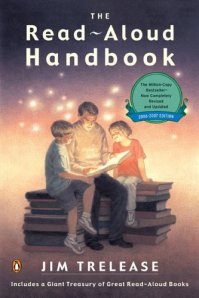
Excerpt from The Read-Aloud Handboook, by Jim Trelease.
Another great resource that is a bit easier to read, is Reading Magic: Why Reading Aloud to Our Children Will Change Their Lives Forever, by Mem Fox.
DO
Begin reading to children as soon as possible.
- Set aside at least one time each day for a story.
- As you read, keep your child involved by asking, “What do you think is going to happen next?”
- To encourage involvement, invite your child to turn the pages for you.
- Use plenty of expression when reading. If possible, change your tone of voice to fit the dialogue.
- Read slowly enough for your child to build mental pictures of what he or she just heard you read.
- When children read to you, it is better for the book to be too easy than too hard.
- Allow time for discussion after reading a story. Thoughts, hopes, fears, and discoveries after reading a story.
- Remember that reading aloud comes naturally to very few people. To do it successfully and with ease you must practice.
Don’t
Don’t read stories that you don’t enjoy yourself. Your dislike will show in the reading and that defeats your purpose.
- Don’t continue reading a book once it is obvious that it was a poor choice. Make sure, however, that you’ve given the book a fair chance to get rolling.
- Don’t be unnerved by questions during reading, particularly from very young children. There is no time limit for reading a book, but there is a time limit on a child’s inquisitiveness.
- Don’t try to compete with television. If you say, “Which do you want, a story or TV? They will usually choose the latter. That is like saying to a nine-year-old, “Which do you want, vegetables or a donut?” You choose.
- Don’t use the book as a threat. (“If you don’t pick up your room, no story tonight!”). As soon as your child sees that you’ve turned the book into a weapon, they’ll change their attitude about books from a positive to a negative.